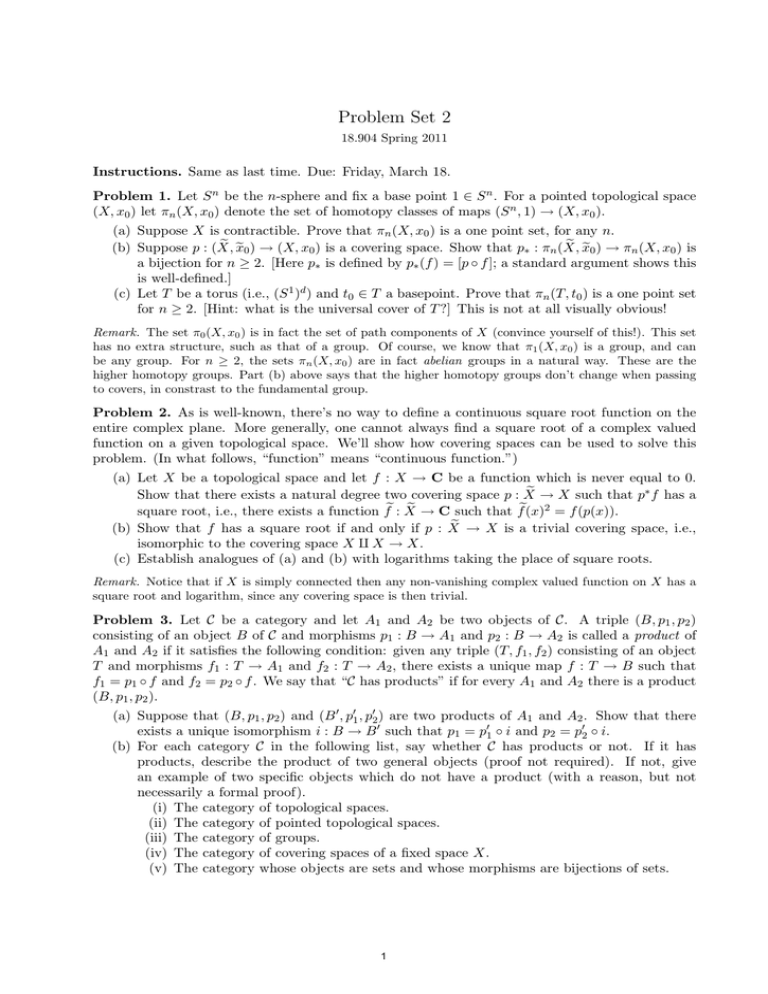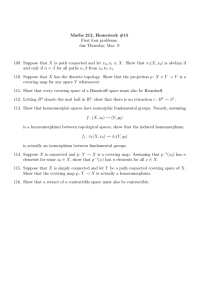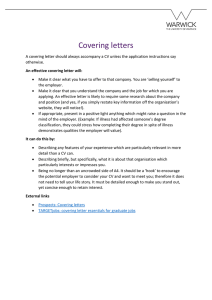Problem Set 2
advertisement

Problem Set 2 18.904 Spring 2011 Instructions. Same as last time. Due: Friday, March 18. Problem 1. Let S n be the n-sphere and fix a base point 1 ∈ S n . For a pointed topological space (X, x0 ) let πn (X, x0 ) denote the set of homotopy classes of maps (S n , 1) → (X, x0 ). (a) Suppose X is contractible. Prove that πn (X, x0 ) is a one point set, for any n. X x X x (b) Suppose p : (X, X0 ) → (X, x0 ) is a covering space. Show that p∗ : πn (X, X0 ) → πn (X, x0 ) is a bijection for n ≥ 2. [Here p∗ is defined by p∗ (f ) = [p ◦ f ]; a standard argument shows this is well-defined.] (c) Let T be a torus (i.e., (S 1 )d ) and t0 ∈ T a basepoint. Prove that πn (T, t0 ) is a one point set for n ≥ 2. [Hint: what is the universal cover of T ?] This is not at all visually obvious! Remark. The set π0 (X, x0 ) is in fact the set of path components of X (convince yourself of this!). This set has no extra structure, such as that of a group. Of course, we know that π1 (X, x0 ) is a group, and can be any group. For n ≥ 2, the sets πn (X, x0 ) are in fact abelian groups in a natural way. These are the higher homotopy groups. Part (b) above says that the higher homotopy groups don’t change when passing to covers, in constrast to the fundamental group. Problem 2. As is well-known, there’s no way to define a continuous square root function on the entire complex plane. More generally, one cannot always find a square root of a complex valued function on a given topological space. We’ll show how covering spaces can be used to solve this problem. (In what follows, “function” means “continuous function.”) (a) Let X be a topological space and let f : X → C be a function which is never equal to 0. X → X such that p∗ f has a Show that there exists a natural degree two covering space p : X X → C such that fX(x)2 = f (p(x)). square root, i.e., there exists a function fX : X X → X is a trivial covering space, i.e., (b) Show that f has a square root if and only if p : X isomorphic to the covering space X I X → X. (c) Establish analogues of (a) and (b) with logarithms taking the place of square roots. Remark. Notice that if X is simply connected then any non-vanishing complex valued function on X has a square root and logarithm, since any covering space is then trivial. Problem 3. Let C be a category and let A1 and A2 be two objects of C. A triple (B, p1 , p2 ) consisting of an object B of C and morphisms p1 : B → A1 and p2 : B → A2 is called a product of A1 and A2 if it satisfies the following condition: given any triple (T, f1 , f2 ) consisting of an object T and morphisms f1 : T → A1 and f2 : T → A2 , there exists a unique map f : T → B such that f1 = p1 ◦ f and f2 = p2 ◦ f . We say that “C has products” if for every A1 and A2 there is a product (B, p1 , p2 ). (a) Suppose that (B, p1 , p2 ) and (B ; , p;1 , p2; ) are two products of A1 and A2 . Show that there exists a unique isomorphism i : B → B ; such that p1 = p;1 ◦ i and p2 = p;2 ◦ i. (b) For each category C in the following list, say whether C has products or not. If it has products, describe the product of two general objects (proof not required). If not, give an example of two specific objects which do not have a product (with a reason, but not necessarily a formal proof). (i) The category of topological spaces. (ii) The category of pointed topological spaces. (iii) The category of groups. (iv) The category of covering spaces of a fixed space X. (v) The category whose objects are sets and whose morphisms are bijections of sets. 1 As with most notions in category theoy, the notion of a product has a dual notion, that of a “coproduct,” obtained by reversing all the arrows in the definition. Precisely, a coproduct of A1 and A2 is a triple (C, i1 , i2 ) consisting of an object C and morphisms i1 : A1 → C and i2 : A2 → C, with a universal property similar to that of the product. (c) Carry out part (b) with coproducts in place of products. Remark. Due to part (a), products are essentially unique, and there is no harm in speaking of “the” product of two objects A1 and A2 (when it exists). This is usually denoted A1 × A2 . Similar remarks apply to the coproduct; the typical notation is A1 I A2 . One of the wonders of category theory is that, after defining a category, all these things like product and coproduct come “for free” — you don’t need to give new definitions for each category. Problem 4. In this problem, we’ll examine covering spaces of topological groups. X → G be a covering map with (a) Let G be a path-connected topological group and let p : G X path-connected. Let X X mapping to 1 under p. Show that there is a G 1 be an element of G X unique group law on G such that X 1 is the identity, p is a homomorphism and multiplication and inversion are continuous. [Hint: use path lifting!] (b) Let G = SL(2, R). In the last problem set, we saw that π1 (G, 1) = Z. By the Galois X →G correspondence, we therefore have a unique connected degree two covering space G X (up to isomorphism), and by (a) we have a canonical group structure on G after choosing X , as a topological group. [Hint: look up “metaplectic group” on X 1. Give a description of G Wikipedia.] Part (b) is really hard, don’t feel bad if you cannot get it (but do try)! Problem 5. Let X be a topological space such that every point has a neighborhood basis of contractible open sets. We’ll show how the groups π1 (X, x), for x varying, can be put together to form a covering space of X. The construction is similar to the that of the universal cover. Let Π(X) denote the set of all homotopy classes of loops in X, i.e., the set of all classes [γ] where γ : I → X satisfies γ(0) = γ(1). Given [γ] ∈ Π(X) and a contractible open neighborhood U of γ(0), let U[γ] consist of all loops of the form [ηγη −1 ] where η is a path in U with η(1) = γ(0). We topologize Π(X) by taking the U[γ] ’s to be a basis. Let p : Π(X) → X be defined by [γ] → γ(0). (a) Show that p is a covering space map. (b) Construct a canonical bijection fx : π1 (X, x) → p−1 (x) for any x ∈ X. (c) Let h be a path in X from x to y. Let ih : π1 (X, x) → π1 (X, y) be the usual isomorphism. Define a map i;h : π1 (X, x) → π1 (X, y) as follows. Given [γ] ∈ π1 (X, x), regard [γ] as an element of p−1 (x) via the isomorphism fx . Let X h : I → Π(X) be a lift of h with X h(0) = [γ]. ; −1 −1 X Define ih ([γ]) to be h(1) ∈ p (x1 ), regarded as an element of π1 (X, x1 ) via fy . Show that ih = ih; . (d) Show that Π(X) is path-connected if and only if X is simply connected. (e) Suppose that X is path-connected and let x0 ∈ X be a basepoint. Let q : X ×π1 (X, x0 ) → X be the trivial covering map, given by q(x, [γ]) = x. Show that (Π1 (X), p) is isomorphic to (X × π1 (X, x0 ), q) as covering spaces if and only if π1 (X, x0 ) is abelian. [Hint: use the result from the first problem set that ih = ih' for any two paths h and h; if π1 (X, x0 ) is abelian. You may also use its converse, without proof. It may also be useful to consider the categorical form of the Galois correspondence.] Remark. The covering space Π(X) is in some ways more natural than the fundamental group, since it does not depend on a base point. There is a natural multiplication map Π(X) ×X Π(X) → Π(X), where ×X denotes the product in the category of covering spaces of X, which gives each fiber p−1 (x) a group law in such a way that each fx is an isomorphism of groups. The covering space Π(X) is closely related to the “fundamental groupoid.” 2 MIT OpenCourseWare http://ocw.mit.edu 18.904 Seminar in Topology Spring 2011 For information about citing these materials or our Terms of Use, visit: http://ocw.mit.edu/terms.







